2002 MERCEDES-BENZ S600 roof
[x] Cancel search: roofPage 250 of 430

247 Driving instructions
Te ch n i c a l
data Instruments
and controlsOperationDrivingInstrument
cluster displayPractical hints Car care Index Driving instructions
Drive sensibly – Save Fuel
Fuel consumption, to a great extent, depends on driving
habits and operating conditions.
To save fuel you should:
•keep tires at the recommended inflation pressures,
•remove unnecessary loads,
•remove roof rack when not in use,
•allow engine to warm up under low load use,
•avoid frequent acceleration and deceleration,
•have all maintenance work performed at regular
intervals by an authorized Mercedes-Benz Center.
Fuel consumption is also increased by driving in cold
weather, in stop-and-go traffic, on short trips and in hilly
country.Drinking and driving
Ped al s
Wa r n i n g !
Drinking or taking drugs and driving can be a very
dangerous combination. Even a small amount of
alcohol or drugs can affect your reflexes,
perceptions and judgement.The possibility of a serious or even fatal accident is
sharply increased when you drink or take drugs
and drive.Please don’t drink or take drugs and drive or allow
anyone to drive after drinking or taking drugs.Wa r n i n g !
Keep driver’s foot area clear at all times. Objects
stored in this area may impair pedal movement.
Page 338 of 430

335 Contents – Practical hints
Te ch n i c a l
data Instruments
and controlsOperation DrivingInstrument
cluster displayPractical hintsCar care Index
Practical hintsFirst aid kit .....................................336
Stowing things in the vehicle ......336
Fuses ................................................337
Hood .................................................339
Checking engine oil level .............342
Automatic transmission
fluid level ...................................343
Active body control (ABC)
fluid level ...................................343
Coolant level ...................................344
Adding coolant ...........................344
Windshield and headlamp
washer system ...........................345
Windshield and headlamp
washer fluid mixing ratio .........345Spare wheel, vehicle tools,
storage compartment ............... 346
Vehicle jack .................................... 347
Wheels ............................................ 348
Tire Replacement ....................... 348
Rotating wheels ......................... 349
Spare wheel .................................... 349
Changing wheels ........................... 351
Tire inflation pressure ................. 356
Battery ............................................. 357
Jump starting ................................. 359
Towing the vehicle ........................ 361
Exterior lamps ............................... 364
Headlamp assembly .................. 365
Taillamp assemblies .................. 368Changing batteries in
the electronic key ..................... 371
Synchronizing
remote control ............................373
Changing batteries in the
KEYLESS-GO-card ..................... 374
Emergency engine
shut-down .................................. 376
Fuel filler flap,
manual release .......................... 376
Emergency operation of
sliding/pop-up roof ...................377
Replacing wiper blades .................378
Roof rack .........................................380
Page 361 of 430
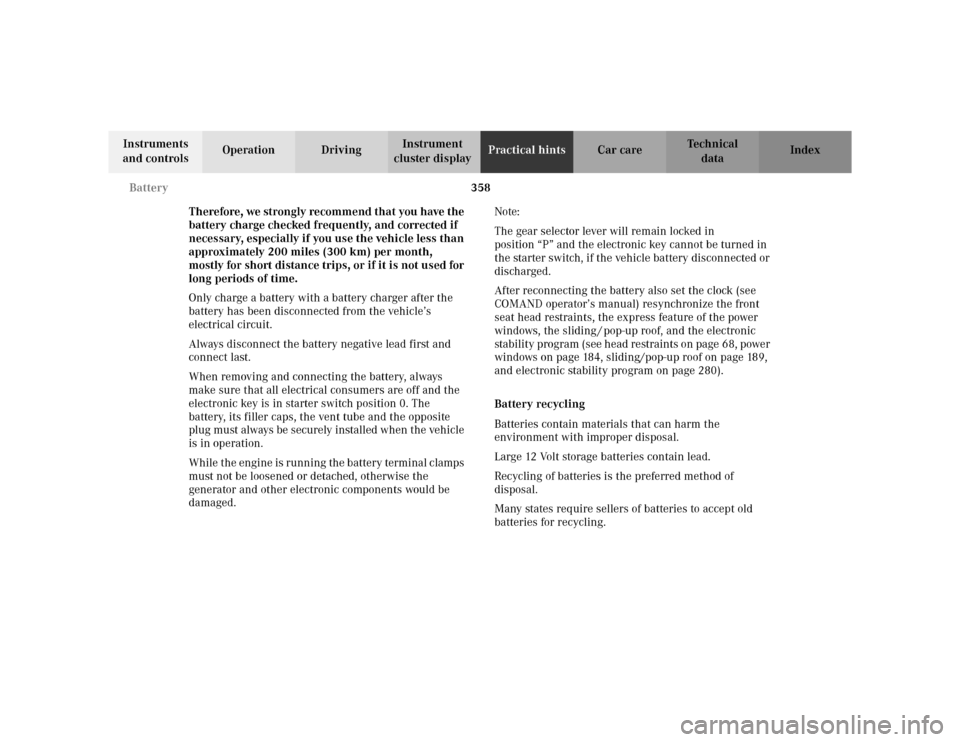
358 Battery
Te ch n i c a l
data Instruments
and controlsOperation DrivingInstrument
cluster displayPractical hintsCar care Index
Therefore, we strongly recommend that you have the
battery charge checked frequently, and corrected if
necessary, especially if you use the vehicle less than
approximately 200 miles (300 km) per month,
mostly for short distance trips, or if it is not used for
long periods of time.
Only charge a battery with a battery charger after the
battery has been disconnected from the vehicle’s
electrical circuit.
Always disconnect the battery negative lead first and
connect last.
When removing and connecting the battery, always
make sure that all electrical consumers are off and the
electronic key is in starter switch position 0. The
battery, its filler caps, the vent tube and the opposite
plug must always be securely installed when the vehicle
is in operation.
While the engine is running the battery terminal clamps
must not be loosened or detached, otherwise the
generator and other electronic components would be
damaged.Note:
The gear selector lever will remain locked in
position “P” and the electronic key cannot be turned in
the starter switch, if the vehicle battery disconnected or
discharged.
After reconnecting the battery also set the clock (see
COMAND operator’s manual) resynchronize the front
seat head restraints, the express feature of the power
windows, the sliding / pop-up roof, and the electronic
stability program (see head restraints on page 68, power
windows on page 184, sliding/pop-up roof on page 189,
and electronic stability program on page 280).
Battery recycling
Batteries contain materials that can harm the
environment with improper disposal.
Large 12 Volt storage batteries contain lead.
Recycling of batteries is the preferred method of
disposal.
Many states require sellers of batteries to accept old
batteries for recycling.
Page 380 of 430

377 Emergency operation of sliding / pop-up roof
Te ch n i c a l
data Instruments
and controlsOperation DrivingInstrument
cluster displayPractical hintsCar care Index Emergency operation of sliding / pop-up roof
The sliding / pop-up roof can be opened or closed
manually should an electrical malfunction occur.
The sliding / pop-up roof drive is located behind the lens
of the left interior overhead light.
Pry off the interior light lens (1) using a screwdriver.Obtain crank (2) (supplied with vehicle) and insert
through hole.
To slide roof closed or to raise the roof at the rear:
turn crank clockwise.
To slide the roof open or to lower the roof at the rear:
turn crank counterclockwise.
See page 189 for instructions on synchronizing the
sliding / pop-up roof after closing manually.
P68.00-0759-26
1
P68.00-2005-26
2
Page 383 of 430
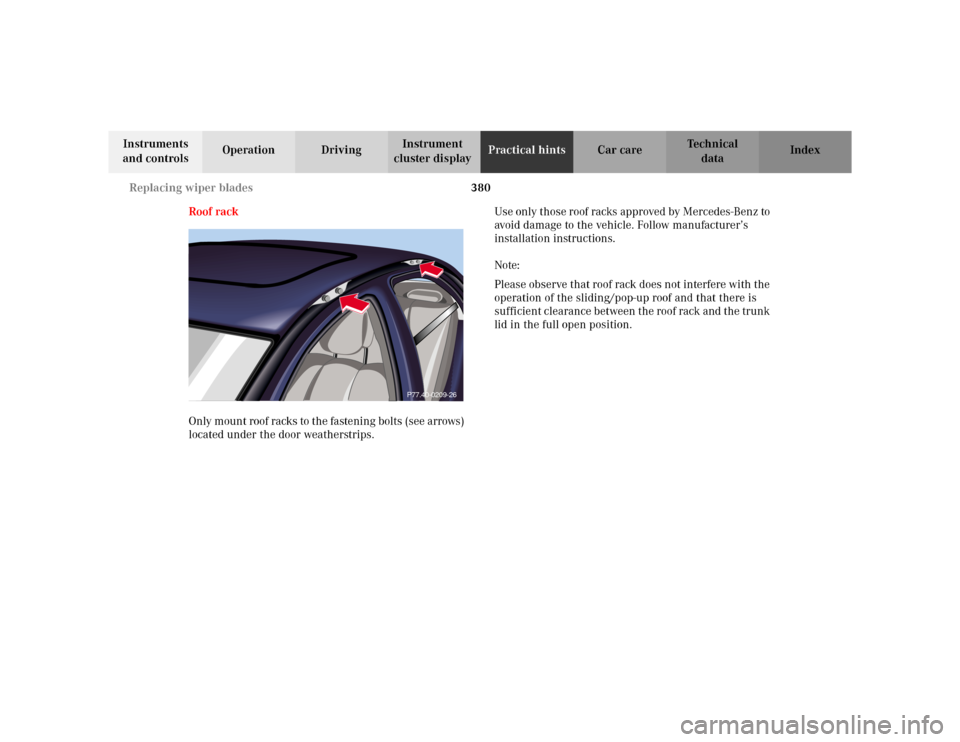
380 Replacing wiper blades
Te ch n i c a l
data Instruments
and controlsOperation DrivingInstrument
cluster displayPractical hintsCar care Index
Roof rack
Only mount roof racks to the fastening bolts (see arrows)
located under the door weatherstrips.Use only those roof racks approved by Mercedes-Benz to
avoid damage to the vehicle. Follow manufacturer’s
installation instructions.
Note:
Please observe that roof rack does not interfere with the
operation of the sliding/pop-up roof and that there is
sufficient clearance between the roof rack and the trunk
lid in the full open position.
P77.40-0209-26
Page 385 of 430
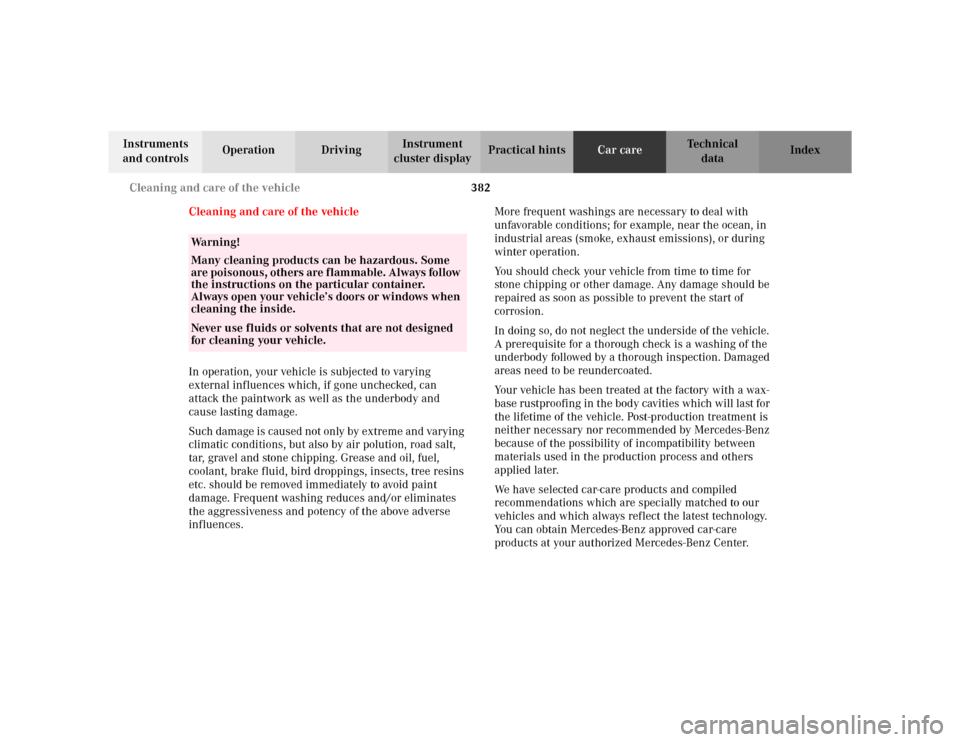
382 Cleaning and care of the vehicle
Te ch n i c a l
data Instruments
and controlsOperation DrivingInstrument
cluster displayPractical hintsCar careIndex
Cleaning and care of the vehicle
In operation, your vehicle is subjected to varying
external influences which, if gone unchecked, can
attack the paintwork as well as the underbody and
cause lasting damage.
Such damage is caused not only by extreme and varying
climatic conditions, but also by air polution, road salt,
tar, gravel and stone chipping. Grease and oil, fuel,
coolant, brake fluid, bird droppings, insects, tree resins
etc. should be removed immediately to avoid paint
damage. Frequent washing reduces and/or eliminates
the aggressiveness and potency of the above adverse
influences.More frequent washings are necessary to deal with
unfavorable conditions; for example, near the ocean, in
industrial areas (smoke, exhaust emissions), or during
winter operation.
You should check your vehicle from time to time for
stone chipping or other damage. Any damage should be
repaired as soon as possible to prevent the start of
corrosion.
In doing so, do not neglect the underside of the vehicle.
A prerequisite for a thorough check is a washing of the
underbody followed by a thorough inspection. Damaged
areas need to be reundercoated.
Your vehicle has been treated at the factory with a wax-
base rustproofing in the body cavities which will last for
the lifetime of the vehicle. Post-production treatment is
neither necessary nor recommended by Mercedes-Benz
because of the possibility of incompatibility between
materials used in the production process and others
applied later.
We have selected car-care products and compiled
recommendations which are specially matched to our
vehicles and which always reflect the latest technology.
You can obtain Mercedes-Benz approved car-care
products at your authorized Mercedes-Benz Center.
Wa r n i n g !
Many cleaning products can be hazardous. Some
are poisonous, others are flammable. Always follow
the instructions on the particular container.
Always open your vehicle’s doors or windows when
cleaning the inside.Never use fluids or solvents that are not designed
for cleaning your vehicle.
Page 404 of 430
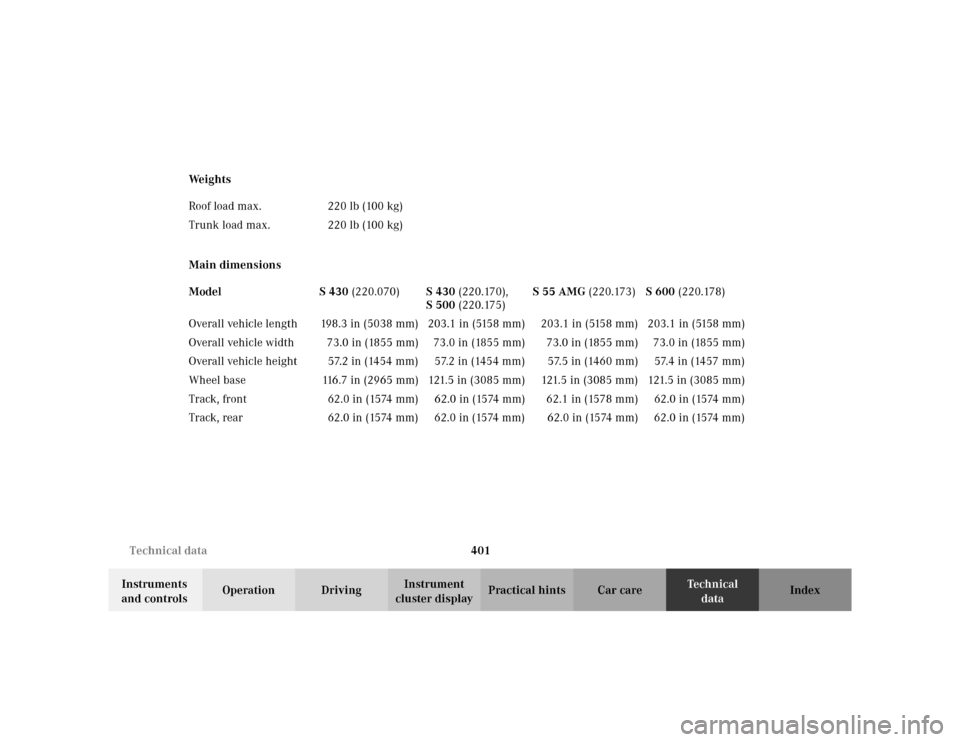
401 Technical data
Te ch n i c a l
data Instruments
and controlsOperation DrivingInstrument
cluster displayPractical hints Car care Index We i g h t s
Main dimensions Roof load max. 220 lb (100 kg)
Trunk load max. 220 lb (100 kg)
Model S 430 (220.070)S 430 (220.170),
S 500 (220.175)S 55 AMG (220.173)S 600 (220.178)
Overall vehicle length 198.3 in (5038 mm) 203.1 in (5158 mm) 203.1 in (5158 mm) 203.1 in (5158 mm)
Overall vehicle width 73.0 in (1855 mm) 73.0 in (1855 mm) 73.0 in (1855 mm) 73.0 in (1855 mm)
Overall vehicle height 57.2 in (1454 mm) 57.2 in (1454 mm) 57.5 in (1460 mm) 57.4 in (1457 mm)
Wheel base 116.7 in (2965 mm) 121.5 in (3085 mm) 121.5 in (3085 mm) 121.5 in (3085 mm)
Track, front 62.0 in (1574 mm) 62.0 in (1574 mm) 62.1 in (1578 mm) 62.0 in (1574 mm)
Track, rear 62.0 in (1574 mm) 62.0 in (1574 mm) 62.0 in (1574 mm) 62.0 in (1574 mm)
Page 417 of 430
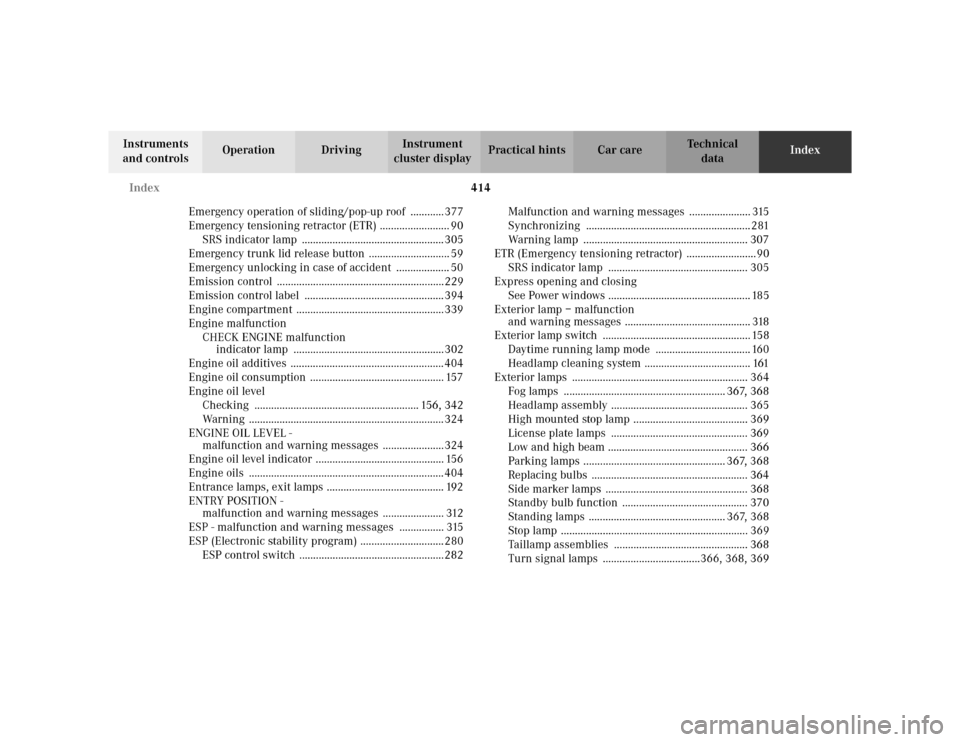
414 Index
Te ch n i c a l
data Instruments
and controlsOperation DrivingInstrument
cluster displayPractical hints Car careIndex
Emergency operation of sliding/pop-up roof ............ 377
Emergency tensioning retractor (ETR) ......................... 90
SRS indicator lamp ................................................... 305
Emergency trunk lid release button ............................. 59
Emergency unlocking in case of accident ................... 50
Emission control ............................................................229
Emission control label .................................................. 394
Engine compartment .....................................................339
Engine malfunction
CHECK ENGINE malfunction
indicator lamp ......................................................302
Engine oil additives ....................................................... 404
Engine oil consumption ................................................ 157
Engine oil level
Checking ........................................................... 156, 342
Warning ...................................................................... 324
ENGINE OIL LEVEL -
malfunction and warning messages ......................324
Engine oil level indicator .............................................. 156
Engine oils ...................................................................... 404
Entrance lamps, exit lamps .......................................... 192
ENTRY POSITION -
malfunction and warning messages ...................... 312
ESP - malfunction and warning messages ................ 315
ESP (Electronic stability program) .............................. 280
ESP control switch ....................................................282Malfunction and warning messages ...................... 315
Synchronizing ........................................................... 281
Warning lamp ........................................................... 307
ETR (Emergency tensioning retractor) .........................90
SRS indicator lamp .................................................. 305
Express opening and closing
See Power windows ................................................... 185
Exterior lamp – malfunction
and warning messages ............................................. 318
Exterior lamp switch ..................................................... 158
Daytime running lamp mode .................................. 160
Headlamp cleaning system ...................................... 161
Exterior lamps ............................................................... 364
Fog lamps .......................................................... 367, 368
Headlamp assembly ................................................. 365
High mounted stop lamp ......................................... 369
License plate lamps ................................................. 369
Low and high beam .................................................. 366
Parking lamps ................................................... 367, 368
Replacing bulbs ........................................................ 364
Side marker lamps ................................................... 368
Standby bulb function ............................................. 370
Standing lamps ................................................. 367, 368
Stop lamp ................................................................... 369
Taillamp assemblies ................................................ 368
Turn signal lamps ...................................366, 368, 369